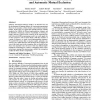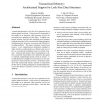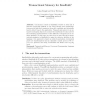22 search results - page 1 / 5 » Semantics of transactional memory and automatic mutual exclu... |
227
click to vote
POPL
2008
ACM
16 years 1 months ago
2008
ACM
Software Transactional Memory (STM) is an attractive basis for the development of language features for concurrent programming. However, the semantics of these features can be del...
103
click to vote
HOTOS
2007
IEEE
15 years 5 months ago
2007
IEEE
We propose a new concurrent programming model, Automatic Mutual Exclusion (AME). In contrast to lock-based programming, and to other programming models built over software transac...
105
click to vote
ISCA
1993
IEEE
15 years 5 months ago
1993
IEEE
A shared data structure is lock-free if its operations do not require mutual exclusion. If one process is interrupted in the middle of an operation, other processes will not be pr...
172
click to vote
SMALLTALK
2007
Springer
15 years 7 months ago
2007
Springer
Concurrency control in Smalltalk is based on locks and is therefore notoriously difficult to use. Even though some implementations provide high-level constructs, these add complexi...
118
click to vote
CCGRID
2007
IEEE
15 years 7 months ago
2007
IEEE
Traditional parallel programming styles have many problems which hinder the development of parallel applications. The message passing style can be too complex for many programmers...



